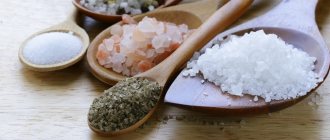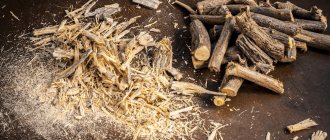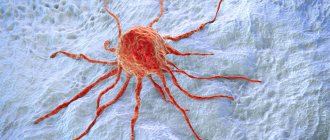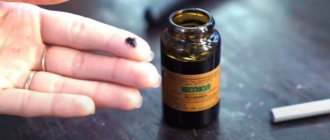Among the various types of industrially produced salt, sea salt is found. In the World Ocean, the quantitative ratios of elements are practically unchanged; on average, they contain up to 35% salt. In closed seas and lakes, the concentration increases due to intense evaporation.
The benefits of sea salt were known back in the ancient world. In ancient chronicles there are references to the preparation of salt baths for King Herod and Queen Cleopatra. Alexander the Great took her with him on campaigns. Warriors were treated with the solution, and salt baths relieved fatigue.
Scientists have long identified the healing properties of crystals. This is a good antiseptic. Cooks have found use for salt as a preservative. Meat, fish, and vegetables kept in evaporated sea water did not undergo the process of rotting, and the food retained its nutrients.
Sea salt: what is it and how is it produced?
Sea salt, unlike table salt, contains not only NaCl, but also other substances. The component composition is natural and corresponds to a concentrated saturated solution of sea water.
There are deposits on the planet left over from dried up seas. The product is extracted from salt baths in the same way as in the old days, by natural evaporation in the sun. Crystals contain a variety of organic residues that impart color and dullness.
Many types of sea salt are produced using this method by extracting minerals from seawater in different parts of the world, mainly in areas where the sun shines all year round.
Salty sea water is poured into shallow open reservoirs (evaporation ponds). Under the influence of the sun and wind, moisture evaporates, and salt crystals of various shapes begin to grow. Then they are subject to drying and purification from foreign impurities.
Chemical composition and nutritional value
It is believed that the entire periodic table is dissolved in the waters of the World Ocean. During the crystallization process, only sodium chloride (NaCl) remains, other halides: bromides, fluorides, iodides:
- potassium;
- calcium;
- zinc;
- Selena;
- copper;
- magnesium
Unrefined salt grains contain silicon, manganese and other useful substances. Some types of salt contain inclusions of bottom sediments and silt, which are characterized by specific properties that give a special taste to food.
The product has no nutritional value, since sea salt does not contain proteins, fats, carbohydrates, and there are no calories in salt. Salt is used for food as a natural flavor enhancer, a source of micro- and macroelements necessary for metabolic processes, as well as for medicinal purposes.
For weight loss
Losing excess weight with sea salt is easy and pleasant. You will be surprised at how quickly the process will go and how fresh and fit your slimmer body will become. Various procedures are used to lose weight: baths, massages with salt, courses of physical exercises in sea water. And salt wraps remove not only extra pounds, but also harmful cellulite.
Losing weight with sea salt is easy and pleasant
Sea salt wraps
A simple procedure gives results at the level of elite beauty salons. The active substances of sea salt, together with excess moisture, remove toxins, stimulating metabolic processes, and eliminate cellulite. The skin is nourished with useful elements, tightened, becomes young and elastic. Experiment: mix various effective additives into sea salt:
- honey;
- ground coffee;
- chocolate;
- seaweed;
- vegetable and essential oils.
A salt wrap can be done by soaking natural fabric in a salt solution.
Application.
- Immediately before the procedure, take a salt bath.
- Mix sea salt in equal proportions with any of the selected additives, add a few drops of ether.
- Warm the mixture a little and rub into the body with circular massage movements.
- Wrap problem areas or the entire body with cling film overnight and take a warm shower in the morning.
- Wraps are done twice a week for one and a half months.
Beneficial features
Treatment with sea salt is justified due to the additional inclusions and beneficial properties of the main component, sodium chloride, for the human body. Due to its natural composition, salt can be eaten and used for medicinal purposes.
There are many “salty” recipes among many peoples of the world, because crystals:
- have a beneficial effect on the body when there is a lack of sodium in the blood, improve the permeability of plasma into cells;
- reduce the risk of developing musculoskeletal diseases associated with cartilage tissue disorders,
- due to the iodine content, they reduce the degree of age-related and pathological changes in the thyroid gland;
- participate in cell regeneration more actively than table salt;
- help increase skin elasticity when applied externally, combine well with honey, activate biostimulation;
- have an antiseptic effect, kill protozoan pathogenic microorganisms and fungi;
- help relieve pain by relieving swelling;
- promote recovery from stress, psycho-emotional overload, are used instead of mineral water;
- A useful hypertonic solution increases overall vitality.
Therapeutic properties also appear when applied externally: the skin is cleansed, metabolic processes in the dermis are accelerated, its elasticity is restored, and collagen production increases.
What is the salt of life?
The chemical composition of human blood plasma and all warm-blooded creatures living on our planet is very close to the composition of sea water. Scientists believe that this is direct evidence that earthly life originated in the oceans. Surprisingly, the amniotic fluid in which the human embryo floats until the moment of birth is a solution of sea salt.
The most ancient magic of nature - salt crystals grow from the sea
The waters of the World Ocean are essentially the blood of the Earth, without which the emergence of life on our planet would have been impossible. And the beginnings of human civilization, according to scientists, arose precisely on the shores of warm seas and large rivers. Man has always been and will be drawn to the sea. Perhaps this is what is called: the call of blood?
Comparative concentrations of the main components of sea salt and human blood plasma - table
| Insoluble precipitate | Na+ | Mg2+ | K+ | Ca2+ | Cl— | SO42- | Br— | |
| Sea salt, % | 0,1 | 30,0 | 2,0 | 3,2 | 0,1 | 55,0 | 0,3 | 0,02 |
| Blood plasma,% | 0,1 | 30,0 | 0,2 | 1,8 | 1,8 | 49,3 | 0,2 | — |
Sea salt treatment has been around for as long as humanity has existed. People intuitively healed wounds in sea water and left many of their ailments in it; breathed salt fumes - and became healthier, stronger, more confident.
The sea is the cradle of humanity
The now fashionable term “halotherapy” (translated from Greek as “healing with salt”) was coined by the legendary father of medicine, Hippocrates, who observed how quickly sea water healed and healed Greek fishermen.
Composition and effectiveness
The chemical formula of sea salt is unstable and largely depends on subjective factors - primarily on the characteristics of the deposit in which a particular salt was mined. But in any case, its composition is many times more diverse than that of table salt. In this regard, both the range of beneficial properties and the scope of use of sea salt in folk medicine are significantly expanding.
Harmony of form and content: a salt crystal is a healing diamond of nature
Naturally, the elements of the periodic table, which are represented in sea salt almost in its entirety, are contained in salt crystals not in pure form, but in certain chemical compounds that directly affect the human body.
The composition of sea salt is rich and varied
Chemical composition of sea salt - table
| Chemical compounds | Content g per 1,000 g of water | % of the total mass of salts |
| Chlorides: | (88,64) | |
| sodium chloride (salty taste) | 27,2 | 77,758 |
| magnesium chloride (bitter taste) | 3,8 | 10,878 |
| Sulfates: | (10,802) | |
| magnesium sulfate | 1,7 | 4,737 |
| calcium sulfate | 1,2 | 3,600 |
| potassium sulfate | 0,9 | 2,465 |
| Carbonates: | (0,532) | |
| magnesium carbonate | 0,1 | 0,315 |
| magnesium bromide | 0,1 | 0,217 |
| Other substances | (0,026) | |
| Sum | 35,0 | 100,0 |
Properties of the main elements of sea salt
Based on the totality of its components, sea water is an ideal healing solution for human health, in which each of the ingredients has its own important function:
- iron - participates in the formation of red blood cells, helps enrich tissues with oxygen, renews them;
- iodine - normalizes hormonal levels, fights infections and their consequences;
- bromine - calms, stabilizes the nervous system, relieves stress and depression;
- sodium and potassium - support the cardiovascular system, cleanse and renew the body at the cellular level;
- calcium - strengthens bones and joints, relieves inflammatory processes, heals and disinfects, improves blood composition;
- silicon - relieves intoxication, stimulates blood supply and capillary permeability;
- magnesium - has an anti-inflammatory and antihistamine effect, participates in the production of antibodies to infections, strengthens blood vessels;
- manganese - normalizes the functions of the pancreas and blood sugar levels, increases the body's resistance;
- copper - stimulates water and mineral metabolism, supports and strengthens the heart muscle, treats inflammation;
- selenium is an antioxidant, promotes the synthesis of enzymes, strengthens the immune system, slows down the aging process of the body;
- chlorine - supports osmoregulation, improves the digestive process, removes toxins, waste and excess carbon dioxide;
- zinc - stabilizes the nervous system, normalizes the production of sex hormones and reproductive function in men and women.
The composition of sea salt is created by all sea organisms: from microscopic algae to ocean giants
White death or not-so-white gold?
Salt is such a natural and constant part of our lives that we usually simply don’t notice it. She is everywhere: in the earth, water and air, in a tear and a drop of blood... She is both plus and minus, good and evil, poison and medicine, life and death. The main thing, as the great Paracelsus used to say, is not to make a mistake with the dose! Only by comprehending this harmony can one fully accept the great gift of healing from salt, which it generously conveys to people.
The usual salt content in sea water does not exceed 35–36 percent. But there are several amazing bodies of water on the planet, the concentration of salts in which is literally off scale. The most famous and famous among them is the Dead Sea in Israel. A liter of local sea water contains 350 grams of salt - ten times more than in the ordinary sea!
The Dead Sea is a natural factory of healing salts
The Dead Sea is actually more of a lake than a sea. And the water in it feels more like oil in tactile sensations: it slides and pushes out. This is a thick, concentrated brine in which habitual forms of life are impossible. The healing potential of super-salty water is enormous, but its improper use is dangerous and can even lead to death.
Dead Sea salt crystals have a very rich healing composition
The unique “Saki salt” is another of the many varieties of sea salt. It is extracted from the brine of the salty Saki Lake and is also called Crimean pink salt. The unusual pinkish tint is not obtained thanks to synthetic dyes - it is a gift from nature. This salt, perhaps the only one among the sea salts, contains a sufficient amount of valuable carotene, which gives it a peculiar reddish tint.
This is how the unique pink brine matures
In addition to a complex of various carotenoids, pink Crimean salt contains about eight dozen more compounds and elements useful for the human body. Compared to other sea salts, the properties of organic iodine, natural waxes and glycerols are the most interesting and promising for medicinal purposes. These natural substances are extremely rarely present in other salts.
Crystals of Saki salt sparkle in the sun with pink reflections
How to choose the most useful one
Sea salt differs from ordinary sodium chloride in its much richer and healthier composition. Yes, baths and other procedures with table salt are also very effective for many health problems, but it’s even difficult to compare with the benefits of sea salt.
Do not buy iodized salt instead of sea salt if you are not sure of its quality
Do not deceive yourself by buying so-called iodized salt - it has nothing to do with sea salt, and will do more harm than any good. The thing is that different salts are prepared with iodine: potassium iodide or potassium iodide. The first compound is unstable and very volatile; soon only its name will remain in the salt. The second compound is more stable, but it is a powerful oxidizing agent and has a destructive effect on the body. In addition, the clean, white, crumbly “extra” itself is a slow-acting poison! To prevent the hygroscopic salt from sticking together into a hard lump, it is also flavored with toxic potassium ferrocyanide, which is closely related to potassium cyanide. This salt fully corresponds to the definition of “white death”.
All useful additives are built into sea salt crystals by nature itself.
In sea salt, iodine is already built into the crystal lattice by nature itself - like most other components. And such salt, by definition, cannot be bright white. Natural salt that has not undergone chemical treatment necessarily contains some foreign impurities and inclusions: small particles of clay, sand, salted algae. This is not dirt or garbage - sea salt always contains a proportion of insoluble elements, and they are also useful for humans.
There is no particular reason to purchase brightly colored, pleasantly smelling sea salt in luxurious “branded” packaging. You will pay 90 percent of the cost for a prestigious brand and stylish design, but in fact - for colorful cardboard and chemical additives. Attempts to somehow refine sea salt are meaningless. She is who she is. And there is no need to try to make it better than nature did.
Beautiful, expensive - but unhealthy and unsafe
Natural sea salt is the best choice in terms of price: quality ratio. It costs mere pennies and consists of crystals of all shades of gray - from yellowish to pink, with a small proportion of insoluble inclusions. Do not chase external presentability; only the natural beauty of sea salt testifies to its natural origin and guarantees maximum healing effect.
How does salt work?
The reserves of sea salt on our planet are innumerable. And this is a resource that you don’t have to worry about, that it’s about to run out. All components of salt are very active - a large “team” of healers works effectively for the benefit of a person. When used correctly, sea salt exhibits all its best properties, positively influencing all organs and systems of the human body:
- stimulates the immune system - turns on self-regulation mechanisms and resists infections;
- cleanses the blood and qualitatively improves its formula - in particular, increases the hemoglobin content;
- heals and stimulates the functions of the endocrine system - improves the functioning of the pancreas and thyroid glands;
- helps strengthen the heart and blood vessels - strengthens and rejuvenates capillaries, supports the heart muscle;
- normalizes the state of the nervous system - relieves fatigue, eliminates the effects of stress and depression;
- treats diseases of the musculoskeletal system - diseases of bones and joints;
- improves skin condition - heals wounds, removes various rashes, accelerates metabolic processes.
All components of sea salt work for human health
Various salt procedures are used not only as purely medicinal - in folk medicine, but also in cosmetology - for the beauty of the face, body, hair and nails, as well as for relaxation, calming and restoration of the body.
Types of sea salt and their characteristics
In stores you can find pink, gray, blue, white and black salt of various grinds. Sometimes it is difficult to make a choice. The composition of sea salt varies due to inclusions, which make up no more than 5% of the total volume.
Black and red types of sea salt from Hawaii. Fleur de Sel looks gray due to inclusions of clay, it is from deposits in France. Amabito No Moshio salt from the Japanese island of Kami-Kamagari is blue. Sugpo Asin is the famous black salt of the Philippines.
It is preferable to choose the one you need based on the medicinal or taste properties of the product. There are expensive types, costing hundreds of dollars per kilogram, and affordable medium-ground crystals.
What is the difference between sea salt and table salt and iodized salt?
Edible sea salt is similar in composition to table salt and is valued by culinary specialists for the natural components contained in the crystals. The natural product is also good because it does not contain evaporators or anticoagulants that prevent caking and the formation of lumps.
As for the iodized product, iodine introduced artificially decomposes over time. And in a bound, crystalline state, the halogen retains its beneficial properties.
Skeptics claim that all salt is the same. But then the chefs of elite restaurants would not order Saki and Hawaiian to prepare special dishes.
From sea salt, through the process of dissolution followed by recrystallization under certain conditions, you can obtain ordinary table salt. You can’t turn a table food into a seafood one. This is the main physical and chemical difference between the products.
What are the benefits of sea salt?
Natural sea salt has beneficial effects on the human body:
- improves blood circulation;
- relieves pain and spasms;
- stimulates metabolism;
- improves the condition of skin, hair, nails;
- normalizes the functioning of the nervous system;
- strengthens the immune system;
- improves respiratory health;
- has a general strengthening effect on the body.
Salt baths allow you to restore strength after heavy physical exertion. Inhaling salt vapors has a beneficial effect on the emotional sphere and relieves stress.
To watch Elena Malysheva’s program about the benefits of salt:
Consumption standards
The average daily intake for an adult is 4-6 grams, which also depends on a number of factors:
- height and weight (the norm is calculated for a weight of 60–80 kg);
- age – older people have a lower need for salty minerals;
- lifestyle - with moderate and increased physical activity, sodium, potassium, and magnesium ions are released in sweat and urine.
Lack and lack of salt are equally dangerous. Only at an early age does the baby have enough minerals that enter the bloodstream with mother’s milk or through artificial formulas. Complementary foods are also not added with salt to reduce the load on the kidneys.
The main aspects of giving up salt
Many detox diets and pseudo-nutritionists advise giving up salt completely. They argue their position with quick weight loss, ease and improvement of the digestive system. But is this really so?
Refusal of salt will lead to disruption of the potassium-sodium balance.
Potassium is the main ion of cells, sodium is the main ion of blood. The balance of the elements ensures the harmony of the nervous/muscular system and the normal distribution of fluids in the body.
The need for elements varies slightly: potassium is required an order of magnitude more. The required ratio of elements is from 1:2 to 1:4. What is the basis for this particular ratio? Our ancestors were primarily gatherers and later hunters. Plant foods are rich in potassium, so there have never been any problems with the supply of the element. It’s more difficult with sodium - people could rarely replenish their reserves, which led to some evolutionary changes. Our body has learned to store sodium in advance, but no such measures were provided for potassium, since plant foods were always at hand. Potassium is easily excreted from the body, and if a person experiences stress, fear and other unpleasant emotions, then potassium loss increases several times. The modern diet is radically different from the prehistoric one. We have unlimited access to foods that contain sodium, but we often forget to include fruits, vegetables and grains in our diet, which causes disharmony.
How to normalize the potassium-sodium balance
It's as simple as that - balance your intake of plant foods and foods containing sodium in a ratio of 1:2 to 1:4.
The daily intake of potassium is from 2 to 4 grams, sodium – from 1 to 2 grams.
With intense physical activity or intense intellectual activity, the indicators can be increased by 1-2 points. List of recommended foods
| Filtered water (1 gram/1 liter) | Sea kale (520 mg) |
| Dried apricots (1900 mg) | Green beans (400 mg) |
| Bran (1150 mg) | Mussels (280 mg) |
| Beans (1100 mg) | Flounder (200 mg) |
| Raisins (1000 mg) | Shrimp (150 mg) |
| Prunes (850 mg) | Celery (100 mg) |
| Parsley (750 mg) | Spinach (80 mg) |
| Peanuts (750 mg) | |
| Pine nuts/almonds/hazelnuts/cashews (750 mg) | |
| Potatoes (630 mg) |
With a rational approach to nutrition, sodium deficiency is excluded. Always check the information and be critical of detox/salt-free diets - they are not always useful and justified. If you engage in intense physical activity, be even more careful about your diet to prevent sodium and potassium imbalances.
For the treatment of ENT diseases and pathologies of the respiratory system
It has long been noted that in caves where salt layers are visible, it is easier to breathe. Mast cells, which cause swelling of the mucous membranes of the respiratory tract, are inhibited, and the air passages are cleared. Salt vapors kill dust mites and fungal spores.
The amazing properties of salt caves are used in speleological sanatoriums; in medical institutions specializing in the treatment of bronchopulmonary diseases, salt rooms are equipped. With the help of vapors and suspensions of sea salt they treat:
- bronchial asthma;
- asthmatic bronchitis;
- chronic tracheitis and tracheobronchitis.
Inhalations are done during the rehabilitation period after pneumonia and tuberculosis.
For treatment, a saturated saline solution is also used (add 3 tablespoons of crystals to 1 liter of warm water). Moisten the cloth, apply a compress to the chest and back at the level of the bronchi, and wrap the patient. Allow to sweat for half an hour. For better sweating, add ½-1 tbsp honey. l.
For internal use (rinses, inhalations), only food products are used; for external use (compresses, rubdowns), bath mixtures can also be used.
Gargling and nasal rinsing
Sea salt solution kills microbes and improves the removal of plugs on the tonsils formed during tonsillitis and purulent tonsillitis. The solution is used for pharyngitis, laryngitis and other diseases of the throat, larynx, and vocal cords.
The brine solution is not made too hot or cold. Method of preparation: 1 tbsp. l. sea salt is dissolved in 200 ml of warm water.
To enhance the therapeutic effect, it is recommended to add infusions:
- oak bark;
- sage;
- thyme;
- chamomile flowers;
- pharmaceutical rotokan (tincture of yarrow, chamomile, calendula).
Inhalations
For inhalation, prepare a saline solution: add 9 g of salt (a little more than 1/2 tablespoon) to 1 liter of water. Mix the solution only in a glass container and store the solution in the refrigerator.
Inhalations are done every other day (up to 4 times a day), the duration of the procedure is 3-5 minutes. The personally prepared solution is used through steam inhalers and nebulizers.
Other medicinal uses
| Disease | Application |
| Atopic dermatitis, seborrhea, psoriasis |
|
| Eczema | Salt dry compresses for a month, every other day. |
| Diseases of the joints and musculoskeletal system | Compresses with 10% saline solution - once a day, once a day, for 2 weeks. |
| Plantar fasciitis (heel spur) | Alternating hot dry salt compresses and baths (2 tablespoons to 2 liters of water) every other day until recovery. |
| Periodontal disease, periodontitis | Rinse with 10% saline solution 3-4 r. a day, every other day. |
| Onychomycosis (fungal nail infections) | Hot baths (2 tablespoons of salt per 1 liter of water with the addition of 5-6 drops of iodine) 2 rubles. per day for 2 weeks. |
| Relieving swelling of the ankle joints | Warm foot baths with 10% saline solution as needed. |
Salt compresses also relieve arthritis pain. For 1 glass of water add 1 tbsp. l. salt, moisten the fabric in the solution, and apply it to the sore spot. Wrap the top with film and a warm scarf. Leave the compress on for up to 2 hours. To enhance the therapeutic effect, it is recommended to add formic or camphor alcohol (½ tsp per glass) to the solution.
For weight loss
Sea salt crystals help you lose weight.
The Ayurvedic procedure Shank Prakshalana, which consists of sequentially drinking a saline solution followed by performing certain exercises, cleanses the intestines, regulates the secretion of the digestive tract, and flushes out all toxins and infestations. A concentrated salt solution (2 tsp per liter of water) is not absorbed by the mucous membranes. The composition passes throughout the intestines, collecting everything unnecessary, disinfects minor damage to the mucous membrane, and inhibits the growth of polyps.
There are other ways to use sea minerals for weight loss:
- wraps - help remove excess water, relieve swelling, and increase muscle tone. The components are mixed in the ratio of 100 g of salt, 60-75 g of ground coffee, 4-5 drops of moisturizing ether. Apply the mass to the body, wrap it in cling film, and leave for 40-50 minutes;
- To get rid of cellulite manifestations, creams and ointments with Dead Sea salts are used. You can make similar compositions yourself: mix the liposuction-effect cream with salt powder (up to 1 teaspoon per 30 g of cream), rub into problem areas with massage movements;
- In a bath, a mixture of honey and salt is applied to the skin: add 1 tbsp to 50 g of honey. l. medium-ground salt, the composition significantly enhances sweating and helps to lose excess weight.
During increased physical activity for weight loss, it is important to replenish the supply of microelements while maintaining the mineral composition. For these purposes, it is recommended to take a lemon-salt drink:
- water – 200 ml;
- lemon – 1 slice;
- salt – ½ tsp.
The solution is drunk in small sips 2 hours after exercise, which will also reduce appetite and quench thirst.
How to take a sea salt bath correctly
Thalassotherapy was used by Hippocrates. Sea bathing has always been prescribed as part of the treatment of nervous and skin diseases. It is useful to combine the effects of sea salt and ultraviolet light. The product is added to private outdoor and indoor pools to improve the antibacterial properties of water.
Add up to 200-300 g of salt to a standard size bath, flavor the water with essential oils (it is convenient to use soluble beads). For children, the concentration is halved.
The duration of the procedure is 15–20 minutes, the recommended water temperature is +38°C. Baths are taken in a course of 7–10 days, after which they take a break for the same period, then the course is repeated. After the procedure, it is advisable to lie down in bed for 30 minutes so that the muscles relax completely.
Cleopatra's bath is the preparation of a salty milk solution. Add 2 tbsp per liter of milk. l. sea salt. A standard size bath will require up to 3 liters of mixture. The skin will become velvety and pleasant to the touch. The duration of the procedure is up to 30 minutes, frequency – 2 times a week.
Personal little sea
To take advantage of the wonderful properties of salt, you don’t have to go to warm, distant seas. At any time of the year and day, you can do this without leaving your home. It is enough to take a handful of sea salt and use it for your own beauty and health. It's simple.
Thanks to sea salt, the little sea will always be with you
Baths and tubs
Baths with sea salt are a procedure that attracts with its accessibility and effectiveness. Warm water, salt and just a little time - that's all you need to
- get a healing and restorative effect;
- remove waste and toxins from the body;
- relax after a busy day and calm your nerves;
- take care of the beauty of your skin and slim figure.
Stock up on sea salt throughout the cold season - eternal summer will settle in your bathroom
Depending on the state of health and the desired goal, the concentration of the solution and the duration of the procedure change. Typically, the course begins with small doses, dissolving a glass of sea salt per bath volume, and gradually increasing the salt content to a kilogram, and in some cases to two kilograms. The first and main rule: you can’t rush.
Because the concentration is immediately very high, the water is hot, and the session is long, healing will not occur instantly. Quite the contrary: you will receive not benefits and pleasure from sea baths, but significant harm to your health.
Salt bath - relax and enjoy!
There are several other recommendations that should be followed to ensure that baths and soaks with sea salt are effective, enjoyable and safe.
- Do not exceed a 10% saline solution concentration.
- Immediately before the procedure, you need to thoroughly cleanse your body skin: take a shower with soap or gel, rub yourself with a scrub; Wipe dry with a towel, and only then, after 15–20 minutes, can you proceed to the main procedure.
- The required amount of sea salt is dissolved in hot water, and this solution is poured into a bath, the optimal temperature of which is 38 degrees; hotter baths are used to treat arthritis and neuritis.
- You need to fill the bath with such a volume of water that its level is below the level of the heart.
- The saline solution can be supplemented with various additives: add 7-10 drops of essential oil to a ready-made bath, add a tablespoon of iodine or half a standard pack of baking soda - depending on the effect you need.
- You should not immerse yourself in a salt bath suddenly, but gradually, monitoring your condition throughout the entire procedure; If even the slightest discomfort appears, stop the procedure.
- You cannot use soap, gel, foam or a washcloth during a salt bath - just relax and enjoy.
- The procedure time varies from twenty minutes to half an hour; the course consists of ten sessions at intervals of one day; after a month's break the course can be repeated.
- Do not wash off the salt water with a shower - pat your skin with a terry towel and lie down for about half an hour - after the bath you should rest.
- It is better to do the procedures in the evening, before going to bed - a bath with salt soothes and relaxes; It is desirable to consolidate this positive effect.
Add aromatic ethers, flowers and herbs to the saline solution - let your feet be happy
These tips are suitable for both a universal, full salt bath and local baths, but in specific cases, adjustments may be made to the recommendations.
Sea salt for beauty and good mood - video
Inhalations
Inhalations with sea salt are used for the prevention and treatment of chronic colds and infectious diseases of the upper respiratory tract, as well as their symptoms: prolonged cough and runny nose. You can inhale hot vapors of dry salt or saline solution. In both cases, various healing additives are used to improve the result: medicinal herbs (chamomile, eucalyptus, sage, thyme, calendula), spices (ginger, cinnamon, mustard, bay leaf), essential oils (fir, pine, violet).
The recipe and duration of the procedure are determined by the doctor depending on the diagnosis and age of the patient. However, there are rules of conduct for procedures that it is advisable to adhere to in any case.
Inhalations with sea salt - the power of the summer sea against winter colds
- For dry inhalations, coarse natural sea salt is heated in a frying pan along with healing additives - for example, pieces of ginger - to about 60 degrees, not higher, so as not to burn the mucous membranes. The pan with salt is transferred to a convenient place and, covered with a towel, the salt vapors are breathed over it for no more than a quarter of an hour. Esters are added immediately before the procedure so that they do not have time to evaporate.
- When inhaling a saline solution, take three tablespoons of salt per liter of alkaline mineral water, mix, add the necessary components (in this case, medicinal herbs are especially good) and bring to a boil with constant stirring. The solution, cooled to 70 degrees, is ready for inhalation, which is carried out according to the same scheme as the dry one.
- The best results are obtained by using a nebulizer for salt inhalations - the concentration of the sea salt solution should be 4-7 percent.
- Inhalations are done in the evening, shortly before bedtime. Soon after inhalation it is better to go to bed. The room you are in must be warm and draft-free - ventilate it in advance.
- It is advisable to lubricate delicate sensitive skin with a neutral cream immediately after the procedure, especially if the inhalation was performed on a child.
Rubbing
Rubbing with salt and fragrant aromatic oils is an old sacrament of Eastern women, which helped them maintain youth and attractiveness for many years. Scrubs and massages with oil-based salt soften and remove the dead skin layer, renew and cleanse it.
Rubbing with sea salt is very simple and effective.
Sea salt for nasal rinsing
Nasal rinsing is an effective and very inexpensive procedure that is excellent for treating chronic runny nose and even sinusitis. Doing it at home is not at all difficult - if you take the washing with full responsibility and follow simple step-by-step recommendations.
- Do not use a syringe for rinsing, even the smallest one for children. It is not known whether you will cure a runny nose, but you are almost guaranteed to get otitis media: the solution from the syringe often spills into the Eustachian tube. A special device for washing is sold in pharmacies and is inexpensive.
- If it is not possible to buy such a device, replace it with a watering can for yogis or, as a last resort, take a regular disposable syringe (the needle, of course, will need to be removed).
- For rinsing, use a 9% solution of salt in boiled water at room temperature.
- The saline solution is poured into the left nostril, tightly closing the right nostril with your fingers. Draw into yourself - the effect is achieved if water from the nose gets into the throat. Then you need to blow your nose and do the same with the other nostril.
- After half an hour, lubricate your nose with oxolinic ointment.
Sea salt will quickly relieve you of that annoying runny nose.
The procedure must be done daily until complete recovery. The process is not very pleasant, so for young children just try drips of a low concentration saline solution into their nose.
Douching
Douching with sea salt is done using an Esmarch mug, but an ordinary syringe will do - just buy a new one, and do not use the one that was already in use; its plastic tip must be boiled immediately before the procedure. Cleanliness is an important component of the effectiveness of douching and guarantees protection against the spread of infection.
Remember to disinfect the tip of the Esmarch mug before each douching
Application.
- For a vaginal douching session you will need about a glass of warm boiled water and a tablespoon of sea salt.
- It is advisable to strain the solution to remove foreign impurities.
- The procedure is carried out slowly and carefully so as not to damage the mucous membrane.
- After finishing douching, you should lie down in a relaxed state for at least half an hour.
Use in beauty recipes
Sea crystals help in treating ailments of the skin of the face and body. Various creams, lotions, and scrubs are produced with the addition of Dead Sea salt components.
When using more affordable salt, the effect is similar; the mixtures are rejuvenated and refreshed. Salt deeply cleanses pores, strengthens the structure of hair and nails.
For face
One of the most effective and safe salt-based products for facial skin is lemon scrub. You will need:
- lemon juice – 1 tbsp. l.;
- honey - 1 tbsp. l.;
- herbal infusion – 1 tbsp. l. (calendula or oak bark are suitable for oily skin; chamomile, sage are suitable for dry skin);
- finely ground salt crystals – 3 tbsp. l.
Mix everything thoroughly and apply to the skin. Leave for 10 minutes, rinse with warm water. The scrub should not be used more than twice a week.
For hair
To activate “dormant” hair follicles and against hair fragility and split ends, strengthening masks are made:
- sea salt is mixed in equal proportions with olive oil;
- add ½ part honey.
The mixture is applied to a clean scalp, wrapped for 30 minutes, then the hair is washed with a small amount of shampoo. The procedure is carried out once a week.
For body
Rubbing with a refreshing solution is recommended: 3 tbsp. l. sea salt, a spoonful of vinegar diluted in a liter of water. Soak a soft terry mitten in the solution and wipe the entire body, starting from the neck, in a circular motion. After a 10-minute procedure, vigor appears throughout the body.
Are there any contraindications?
As the great Avicenna said, everything is medicine, and everything is poison, you just need to know when to stop. This also applies to salt consumption.
If the daily norm is constantly exceeded (sodium chloride in finished products, semi-finished products, canned food, etc. is taken into account):
- blood pressure increases;
- blood vessels become fragile, the risk of stroke increases;
- the water balance is disturbed, swelling appears;
- heart failure develops;
- kidney function is disrupted, filtration functions are inhibited;
- the blood becomes thick, microcirculation slows down;
- Bile thickens, plaque forms on the walls of the bile ducts, and congestion occurs.
Sea salt is not recommended for everyone; the benefits and harms depend on the specific application. In China, salt crystals were used for suicide. It has been established that for each person there is a critical norm for the consumption of this mineral.
Limit the consumption of sodium chloride and sea salt, including external use:
- people suffering from hypertension;
- patients with rosacea, skin rashes of a neurotic nature (neurodermatitis);
- for cardiac and vascular pathology.
Colored salts containing plant and mineral natural components should be used with caution by allergy sufferers.
The use of salt is not indicated for children under 3 years of age due to the incomplete formation of immunity and the need for gentle nutrition.
Water procedures with salt additives are contraindicated:
- late pregnant women;
- drunk and highly intoxicated;
- people with coronary pathologies.
Abusing “salty” recipes is also contraindicated for healthy people. Regular use requires consultation with a doctor.
Why we like salty food
Nowadays, diets that promote giving up salt are in fashion, but there is nothing good or healthy about it. Salt in moderation is vital for maintaining health. On average, our bodies contain about 100 grams of sodium. This component is well known to us from the school periodic table, where it is marked as sodium (Na⁺). This is an electrolyte that is extremely important for maintaining normal blood pressure, water-salt balance, and for the proper functioning of the transmission of nerve impulses. The latter, for example, is responsible for transmitting the satiety signal from the stomach to the brain. If the transmission of nerve impulses is disrupted, a person begins to overeat and the brain belatedly learns about our satiety. Does it make sense to go on a salt-free diet in this case?
Chlorine (Cl⁻) is also important - it helps sodium perform its functions. Their concentration in our body is very strictly regulated; the body does not give them the opportunity to go into surplus (exceeding the norm). Everything that is above the norm is excreted daily through sweat and other natural means. But deficit is also bad. That is why, after diseases of the gastrointestinal tract, doctors recommend replenishing the water-salt balance with the help of mineral drinks containing sea salt.
In a word, our craving for salty foods is a normal instinct that should not be suppressed. Everything should be within normal limits.








